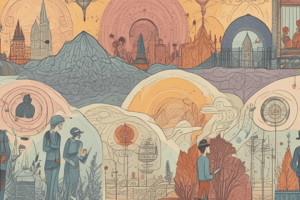Podcast
Questions and Answers
What is a characteristic of an annual species?
What is a characteristic of an annual species?
- It completes its life cycle in 12 months or less (correct)
- It invests a lesser proportion of resources in reproduction
- It has multiple reproductive events in its lifetime
- It persists for many growing seasons
What type of life cycle is characterized by one reproductive event followed by death?
What type of life cycle is characterized by one reproductive event followed by death?
- Semelparous (correct)
- Overlapping iteroparous
- Continuous iteroparous
- Iteroparous
Which type of organism has discreet, non-overlapping generations?
Which type of organism has discreet, non-overlapping generations?
- Annual (correct)
- Semelparous
- Iteroparous
- Perennial
What is a key difference between semelparous and iteroparous species?
What is a key difference between semelparous and iteroparous species?
Which type of life cycle is characterized by an organism that persists for many growing seasons?
Which type of life cycle is characterized by an organism that persists for many growing seasons?
What is a characteristic of an iteroparous species?
What is a characteristic of an iteroparous species?
What is a key difference between continuous and overlapping life cycles?
What is a key difference between continuous and overlapping life cycles?
Which type of life cycle is characterized by an organism that may or may not overwinter as a non-seed or non-egg?
Which type of life cycle is characterized by an organism that may or may not overwinter as a non-seed or non-egg?
What is a characteristic of a semelparous individual?
What is a characteristic of a semelparous individual?
What is a key difference between annuals and perennials?
What is a key difference between annuals and perennials?
What is a characteristic of an iteroparous individual?
What is a characteristic of an iteroparous individual?
What is an example of an overlapping semelparous life cycle?
What is an example of an overlapping semelparous life cycle?
What is a characteristic of continuous iteroparous species?
What is a characteristic of continuous iteroparous species?
What is a key difference between semelparous and iteroparous individuals?
What is a key difference between semelparous and iteroparous individuals?
What is a characteristic of perennial life cycles?
What is a characteristic of perennial life cycles?
What is a key difference between annuals and perennials in terms of energy investment?
What is a key difference between annuals and perennials in terms of energy investment?
What is a characteristic of semelparous organisms?
What is a characteristic of semelparous organisms?
What is the primary difference between annual and perennial life cycles?
What is the primary difference between annual and perennial life cycles?
In terms of energy investment, what is a key difference between semelparous and iteroparous organisms?
In terms of energy investment, what is a key difference between semelparous and iteroparous organisms?
What is the result of the trade-offs between life history traits?
What is the result of the trade-offs between life history traits?
What would be the characteristics of a 'Darwinian Demon'?
What would be the characteristics of a 'Darwinian Demon'?
What is the key assumption underlying life history theory?
What is the key assumption underlying life history theory?
What is the result of constraints on life history strategy?
What is the result of constraints on life history strategy?
What determines an organism's Darwinian fitness?
What determines an organism's Darwinian fitness?
Flashcards are hidden until you start studying
Study Notes
Life Histories
- Life histories are the combination of characteristics that define an organism's life cycle
- Main types of life cycles include:
- Annuals vs perennials
- Semelparous vs iteroparous
Semelparous vs Iteroparous
- Semelparous: individual has one single reproductive event during its life, then dies
- Iteroparous: individual may have many reproductive events (during season or life)
- Invests large amount of energy in reproduction vs invests lesser proportion of resources in reproduction
Overlapping vs Continuous
- Overlapping semelparous: generations overlap, but still die after reproduction
- Overlapping iteroparous: multiple reproductive events, but with overlap between generations
- Continuous semelparous: continuous reproduction, but still dies after reproduction
- Continuous iteroparous: continuous reproduction with multiple events
Annuals vs Perennials
- Annuals: complete life cycle in 12 months or less
- May or may not overwinter as non-seed/egg
- Perennials: persist for many growing seasons
- One part of the organism dies/gets absorbed and regrows from the following season
Life History Traits
- Measurable characteristics or attributes that affect survival and reproduction
- Examples:
- Size at birth
- Growth rate
- Age/size at maturity
- Number and size of offspring
- Age/size-specific reproductive investments
- Age/size-specific mortality schedules
- Lifespan
- The combination of traits determines Darwinian fitness
Life History Theory
- Key assumption: there are trade-offs among life history components
- "Reproduction is costly, and so is growth" – Trade-off
- Constraints shape the life history strategy of species
- Examples of constraints include:
- Limited resources
- Environmental pressures
- Predation
- Optimization of survival and reproduction is favored by selection
Studying That Suits You
Use AI to generate personalized quizzes and flashcards to suit your learning preferences.



